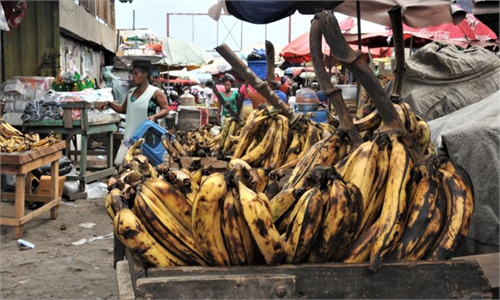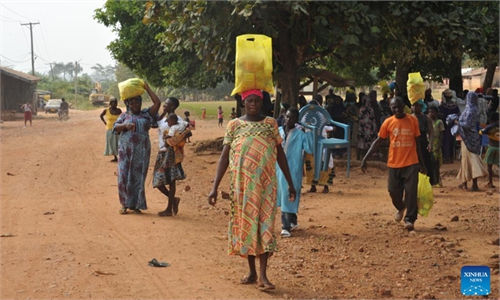Ghana’s farmers arm themselves against freak weather with crop insurance
Incentivized protection

A farmer poses for a photo carrying pineapple plants to be transplanted at the Greenfields Pineapple farm in Ekumfi, Ghana on June 29, 2018. Photo: AFP
As the sun slid toward noon, Adam Fuseina's daughter jumped off a bicycle at their home in Nafaring village, northern Ghana, and called out to her mother that she was back from shopping.
Fuseina looked at the basket full of cooking oil, flour, greens and other items on the bike's front rack and smiled at the agriculture officials who were visiting her farm.
"This will keep us going for a week," said the 43-year-old mother of five, standing amid the village's mud-walled shelters with fraying thatched roofs.
Things were very different a year ago, when Fuseina's family could sometimes only manage one meal a day.
Ghana's worsening floods and droughts have made growing fruit and vegetables harder, and when the staple maize and rice crops are hit as well, families like hers are left with meager yields of grains that lack essential nutrients and vitamins.
But in March 2021, Fuseina joined a free crop insurance project that tries to ensure farmers aren't thrown into poverty by the extreme weather, pest infestations and crop disease outbreaks becoming increasingly destructive as global temperatures rise.
Now when long dry spells destroy a share of the crops on Fuseina's 6.5-acre (2.6-hectare) farm, her family can still eat healthily, she said.
Since joining the pilot project run by social enterprise Roots of Change, she has received two payouts of up to 200 Ghanaian cedis ($33), covering 80 percent of the value of her crop losses to drought.
Those may be tiny payouts, but combined with low-interest loans of nearly 600 cedis that come as part of the insurance package they have helped supplement the income she makes and carry the family through to the next planting season, she said.
"I cannot wait to plant new crops on my farm because I know I will get returns whether there is bad weather or they are attacked by pests and diseases, thanks to crop insurance. Before the program I never felt excited," Fuseina said.
Part of a larger initiative by Roots of Change, under the Britain-based charity Opportunity International, the insurance program uses farmland and crop data collected by the agriculture ministry to help provide cover for about 1,360 farmers in northern Ghana.
The Ghana Agricultural Insurance Pool (GAIP), a group of 15 insurance providers, compare data on historical farm yields to actual harvests to verify insurance claims enrolled farmers make.
Since it was launched in 2021, the project has paid out 7,000 cedis ($1,120) to more than 300 farmers, according to Ebenezer Laryea, the Ghana head of agricultural businesses at Opportunity International, which pays the farmers' insurance premiums.
Some farmers invest the money they get through the program into community savings schemes, where people pool their funds to be used by individual members when they need it.
"Crop insurance is a game changer," Laryea said, particularly in a country where about half of people make their living from farming.
More stable farming
As temperatures rise in Ghana as a result of climate change, the country's northern region no longer gets two rainy seasons of a few months each but one five-month-long wet season, which can flood fields and drown crops, Laryea said.
The rest of the year is dry, leaving crops parched.
Food and agriculture minister Owusu Afriyie Akoto has said crop insurance could make farming a more stable livelihood and attract more young people to an occupation now dominated by the aging.
"It is not just about building resilience against erratic weather but also making agriculture attractive to youth and women by making it a financial asset," he said at the 2021 African Green Revolution Forum in Nairobi.
Ghana's Food and Agriculture Ministry did not respond to the Thomson Reuters Foundation's requests for comment.
Building trust
GAIP first introduced crop insurance to Ghanaian farmers in 2011, but studies show it has been a tough sell.
Uptake has been slow in rural areas, mostly due to a lack of understanding of how insurance works, said a study published in June 2021 in the BioMed Central (BMC) journal.
It shows 90 percent of small-scale farmers see crop insurance as a useful tool, but less than a fifth said they had signed up for it.
Over half of farmers responded that they lacked adequate knowledge about insurance, and about 5 percent said it is too expensive.
Another issue was the farmers' lack of trust in how companies calculate insurance payouts.
Early crop insurance programs-based payouts on a weather index, with insurance triggered when a preset number of days passed without rain, for instance.
But in Ghana and some other parts of Africa weather data is known to be imprecise, said Hedwig Siewertsen, head of inclusive finance at the Alliance for a Green Revolution in Africa (AGRA), an agricultural nonprofit. xNewer models make the process of calculating crop loss more accurate.
In the Roots of Change program, the agriculture ministry uses satellite data to project how much each farmer could produce per acre, then compares that to the actual harvest during a visit to any farm making a claim, said Ibrahim Sulley, an agriculture relationship officer with the social enterprise.
The program's officers expect to visit about 335 farms a year to follow up on insurance claims, noted Lydia Baffour Awuah, the Roots of Change senior program manager for Ghana.
Sending people to visit farms is more expensive than a weather-index-based insurance model, but the interaction with farmers brings other benefits, backers say.
Siewertsen at AGRA said that a face-to-face relationship is vital if insurance is going to gain traction.
"The main issue in agricultural insurance is gaining the trust of farmers," he said in an email interview.
"This can be done through field presence, first to explain how insurance works and second to show that the actual damage is seen and measured," he added.
Reuters



